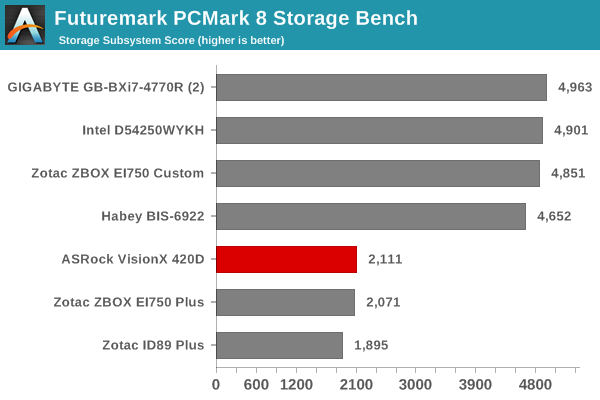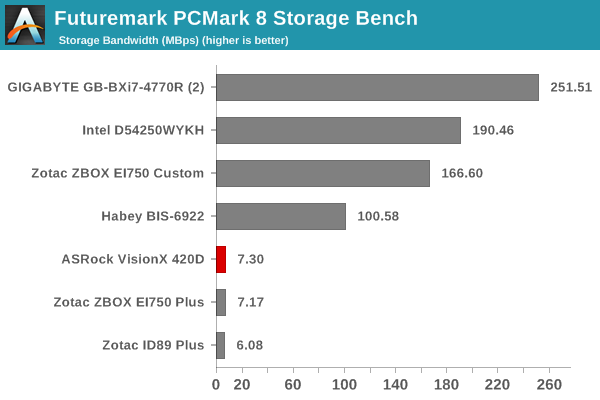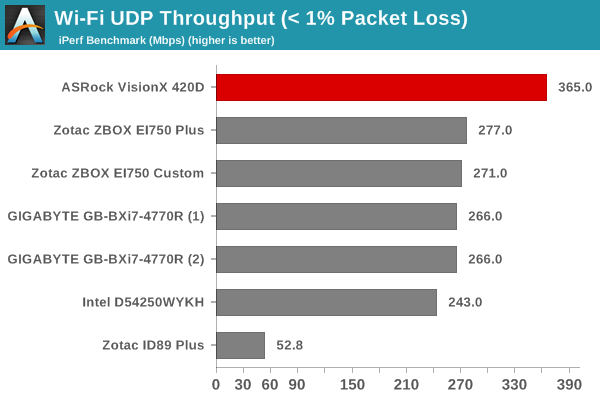VisionX 420D Review: ASRock's mini-PC Lineup Continues to Impress
by Ganesh T S on September 1, 2014 9:00 AM ESTNetwork & Storage Performance
We have recently started devoting a separate section to analyze the storage and networking credentials of the units under review. On the storage side, one option would be repetition of our strenuous SSD review tests on the drive(s) in the PC. Fortunately, to avoid that overkill, PCMark 8 has a storage bench where certain common workloads such as loading games and document processing are replayed on the target drive. Results are presented in two forms, one being a benchmark number and the other, a bandwidth figure. We ran the PCMark 8 storage bench on selected PCs and the results are presented below.


The absence of a SSD brings down the benchmark numbers heavily for the VisionX 420D. Given the cost of the unit, it would have only been fair for consumers to expect a 64 GB boot SSD drive or mSATA drive backed up by a hard drive of lower capacity than the currently shipping 1 TB version.
On the networking side, we restricted ourselves to the evaluation of the WLAN component. Our standard test router is the Netgear R7000 Nighthawk configured with both 2.4 GHz and 5 GHz networks. The router is placed approximately 20 ft. away, separated by a drywall (as in a typical US building). A wired client (Zotac ID89-Plus) is connected to the R7000 and serves as one endpoint for iPerf evaluation. The PC under test is made to connect to either the 5 GHz (preferred) or 2.4 GHz SSID and iPerf tests are conducted for both TCP and UDP transfers. It is ensured that the PC under test is the only wireless client for the Netgear R7000. We evaluate total throughput for up to 32 simultaneous TCP connections using iPerf and present the highest number in the graph below.

In the UDP case, we try to transfer data at the highest rate possible for which we get less than 1% packet loss.

It is a bit surprising to see TCP perform better than UDP, but, apparently, that is quite possible in certain circumstances with iPerf.
The ASRock VisionX 420D comfortably wins the WLAN benchmarks. The Broadcom BCM4352 is a 2x2 802.11ac solution, and it is able to deliver better results compared to other 2x2 solutions (such as the Intel AC7260) with the Broadcom-based Nighthawk router. On the subject of networking, it is also heartening to see the Intel I217-V Ethernet adapter enabling the Gigabit NIC.










30 Comments
View All Comments
mschira - Monday, September 1, 2014 - link
Nice article, and interesting machine. I think the hardware documentation and pictures could be a bit better (disassembly), but otherwise a decent work.The lack of blue ray and 4K decoding are the obvious shortcomings, though mostly when one has a 4K TV - which I guess not many do.
boxof - Monday, September 1, 2014 - link
Any chance we can start getting sound recordings as part of SFF reviews? It'd be useful to get a sense of the nature of the sound (e.g. whiny) under load. Perhaps post some audio up to soundcloud or youtube if bandwidth is a concern.albiglan - Monday, September 1, 2014 - link
I'm also surprised by the lack of Blu-Ray option, but am noticing this more and more on laptops as well (no ODD, but if there is, it seems DVD only). I'm wondering if it is just a cost thing or if the format is on the decline?ET - Tuesday, September 2, 2014 - link
Yes, my problem with this too. Looks like a great little gaming HTPC but I'd love a blu-ray and a 2TB HD option (I'll add an mSATA SSD myself). Really, my current HTPC is a little long in the tooth, but has the benefit of 3.5" HD and standard 5.25" Blu-Ray drive support.Gadgety - Tuesday, September 2, 2014 - link
"The VisionX 420D has a much better acoustic profile compared to the BRIX Pro and even the ZBOX EI750 (thanks to the larger chassis, which, in turn, allows for a better thermal solution). Subjectively speaking..."Nice article. There's detailed objective measurements for just about every metric conceivable.That said there's always room for improvement. I find acoustics and noise to be just about the only area left to subjective impressions. Why is that? For these small boxes cooling and noise is where it's at in terms of separating the winners from losers, and that area is left to subjective impressions. Please include measurements and graphs of acoustic noise levels and signatures.
dj_aris - Tuesday, September 2, 2014 - link
Systems of such footprint literally crave for Maxwell. Maxwell is out for like 7 months now, why isn't it alredy in the hands of OEMs? AW Alpha is great and all but it's not here yet. Even Gigabyte has a low profile 750Ti ready now, I bet Asrock could have managed to fit that easily inside and make a perfectly capable mid/high 1080p machine.milkod2001 - Tuesday, September 2, 2014 - link
I'm not sure if there's something to like about 420D except the size.Looking at specs(medium class mobile CPU & GPU) and price($860),420D is basically laptop with no keyboard and screen. When you add cost of HD screen and keyboard(min.$120) you could get laptop with i7 quad & Maxwell 880M or proper PC gaming machine.
420D is pretty much useless for gaming unless you are happy with 7-13fps on 1080p and overkill & overpriced as office PC/HTPC.
I'm very confused with reviewer quite positive conclusion. What I'm missing here?
ganeshts - Tuesday, September 2, 2014 - link
The market segments are different. $120 in savings is still $120 when the use-case involves a notebook being docked to a display almost all the time.On the other hand, there is a reason why SFF PCs are becoming more and more popular compared to full-blown PC gaming machines - people appreciate and are willing to pay the premium for it. If the BRIX Pro and ZBOX EI750 are good Steam machines, the 420D is definitely much better at that job.
TrackSmart - Wednesday, September 3, 2014 - link
I think the point the poster is making is that these are *laptop specs* in a small PC that is marketed to gamers -- which means pretty weak performance.Someone interested in gaming (the target audience) would be much better off getting a slightly larger chassis with a low-power desktop CPU and GPU. You'd still get a fairly small chassis and low power consumption, but with a HUGE boost in gaming performance. That makes a lot more sense to me, given the supposed target audience (gamers).
Shadowmaster625 - Thursday, September 4, 2014 - link
For $100 more you can get a Yoga Y50 with a maxwell based gtx 860m. I'm sure there are several notebooks with better specs that are cheaper. What is the purpose of this form factor given the price premium compared to both desktops AND notebooks????